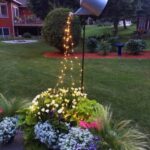Designing an Herb Garden Layout is a crucial step in creating a functional and visually appealing space for growing your favorite herbs. Whether you are a seasoned gardener or just starting out, having a well-designed layout can significantly enhance your gardening experience. From aesthetics to functionality, there are numerous benefits to carefully planning and organizing your herb garden.
When you design an herb garden layout, you not only create a beautiful outdoor space but also maximize the functionality of your garden. By arranging your herbs in an organized manner, you can easily access and maintain them. Additionally, a well-thought-out layout allows you to make the most of the available space, making it easier to manage and care for your plants.
Aside from the practical aspects, designing an herb garden layout also provides aesthetic appeal. When planned effectively, an herb garden can be an attractive addition to any landscape. Whether you prefer a traditional, formal design or a more whimsical layout, there are endless possibilities for creating a visually pleasing display of herbs.
In the following sections, we will explore various aspects of designing an herb garden layout. From choosing the right location to understanding different types of herb gardens, we will provide valuable insights and tips to help you create your ideal herb garden. So grab your gardening gloves and get ready to design a stunning and functional herb garden that will bring joy and flavor to your life.
Benefits of Designing an Herb Garden Layout
When it comes to designing an herb garden layout, there are several benefits that come with careful planning. One of the most notable advantages is the improved aesthetics. By designing a well-thought-out layout, you can create a visually appealing garden that not only enhances the overall look of your outdoor space but also adds a touch of natural beauty.
A well-designed herb garden layout also brings functionality to your space. By strategically placing herbs and considering their growth habits, you can ensure easy access for harvesting and maintenance. The layout can be designed to accommodate different herbs and their specific needs, such as sunlight requirements or soil preferences. This allows for efficient care and management of the plants in your garden.
Additionally, a thoughtfully designed herb garden layout can contribute to better organization and productivity. With the right placement of different herbs and designated areas for each type, it becomes easier to find and identify specific herbs when needed. This is especially useful when you are cooking or using the herbs for medicinal purposes.
To achieve these benefits, it is important to consider various factors when designing your herb garden layout. Factors such as sunlight exposure, soil quality, drainage, proximity to water source, and space availability all play a crucial role in determining the success and functionality of your herb garden. By taking these factors into account during the design process, you can create an optimal environment for your herbs to thrive.
Choosing the Right Location for Your Herb Garden
When it comes to designing an herb garden layout, one of the most important steps is choosing the right location for your garden. The location you choose will greatly impact the success and productivity of your herb garden. There are a few key factors to consider when selecting the perfect spot for your herbs.
First and foremost, it’s important to choose a location that receives ample sunlight. Most herbs require at least 6 hours of direct sunlight each day in order to thrive. Take note of how the sun moves across your yard throughout the day and choose a spot that will provide consistent sunlight for your herbs.
In addition to sunlight, it’s also essential to consider the soil conditions in your chosen location. Herbs generally prefer well-draining soil that is rich in organic matter. Conduct a soil test in your desired location or observe whether the area is prone to waterlogging or excessive dryness. If necessary, you may need to amend the soil with compost or other organic matter to create optimal growing conditions for your herbs.
Finally, think about accessibility when selecting a location for your herb garden. Ideally, you’ll want a spot that is easily accessible from your kitchen so you can quickly grab fresh herbs whenever needed. Consider placing your herb garden near an outdoor cooking area or close to a door that leads directly into your kitchen.
By carefully considering these factors when choosing a location for your herb garden, you’ll set yourself up for success and ensure that your herbs thrive in their new home.
Understanding the Different Types of Herb Gardens
When designing an herb garden layout, it is essential to first understand the different types of herb gardens available. Each type has its own unique characteristics and requirements, catering to different preferences and needs. Here are some of the most common types of herb gardens:
1. Culinary Herb Garden: This type of herb garden focuses on growing herbs that are typically used in cooking and culinary purposes. Popular herbs for culinary gardens include basil, thyme, rosemary, parsley, and mint. These gardens are usually located near the kitchen for easy access to fresh herbs while cooking.
2. Medicinal Herb Garden: This type of herb garden is designed specifically for growing herbs that are known for their medicinal properties. Examples of medicinal herbs include chamomile, echinacea, lavender, and peppermint. Medicinal herb gardens can be useful for those interested in natural remedies and herbal medicine.
3. Fragrant Herb Garden: As the name suggests, fragrant herb gardens are dedicated to growing aromatic herbs that release pleasant scents when touched or brushed against. Some examples of fragrant herbs are lavender, lemon balm, thyme, and sage. These gardens can be a delightful addition to any outdoor space or garden.
4. Tea Herb Garden: A tea herb garden is designed for those who enjoy brewing their own herbal teas at home. Examples of commonly grown tea herbs include chamomile, lemon verbena, mint (peppermint or spearmint), and lemongrass. Creating a tea herb garden allows you to have a ready supply of fresh ingredients for homemade herbal teas.
It’s important to note that these types of herb gardens are not mutually exclusive – you can incorporate elements from different types into your own personalized herb garden design based on your preferences and needs. Understanding the different options will help you make informed decisions about which herbs to include in your garden as well as how to create a layout that suits your specific purposes.
Factors to Consider When Designing an Herb Garden Layout
When designing an herb garden layout, there are several important factors to consider in order to ensure that your garden thrives and meets your specific needs. Taking these factors into account will help you create a well-designed and functional space that is both visually appealing and practical.
Sunlight and Shade
One of the most crucial factors to consider when designing an herb garden layout is the amount of sunlight and shade that your herbs will receive. Most herbs require at least six hours of direct sunlight each day in order to grow and thrive.
Therefore, it is important to choose a location for your herb garden that receives ample sunlight throughout the day. Take note of any areas in your garden that are shaded by trees or buildings, as these may not be suitable for growing certain types of herbs.
Soil Quality and Drainage
The quality of your soil plays a vital role in the success of your herb garden. Most herbs prefer well-drained soil with a slightly acidic pH level. Conduct a soil test to determine the pH level of your soil and make appropriate amendments if necessary.
Additionally, ensure that the soil drains well to prevent waterlogging, which can lead to root rot or other diseases. If you have clay-like soil that retains too much moisture, consider adding organic matter such as compost or sand to improve drainage.
Accessibility
Consider the accessibility of your herb garden when designing its layout. You will want to be able to easily reach all areas of the garden for planting, harvesting, and maintenance tasks such as watering or weeding. Avoid placing plants too close together or against walls or fences, as this can make access difficult. Leave enough space between rows or beds so that you can comfortably navigate through the garden without stepping on or damaging plants.
By taking these key factors into consideration when designing your herb garden layout, you can create a space that promotes healthy growth and makes caring for your herbs easier. Whether you have a small plot or a larger space, careful planning will ensure that your herb garden is both aesthetically pleasing and functional.
Designing the Layout
When designing the layout for your herb garden, there are several key elements that you should consider including. These elements will not only enhance the visual appeal of your garden but also contribute to the overall functionality and ease of maintenance. Here are some important elements to include in your herb garden layout:
Pathways
Including pathways in your herb garden is not only aesthetically pleasing but also practical. Pathways allow easy access to different areas of the garden, making it convenient for harvesting herbs or tending to their needs. You can choose from various materials such as gravel, stepping stones, or even create a mini brick path to add charm and character to your herb garden.
Planting Beds
Creating clearly defined planting beds is essential for organizing and segregating different types of herbs in your garden. Consider using raised beds or containers to separate each type of herb, making it easier for you to manage individual plants and ensure proper growth conditions. Additionally, planting beds provide space for necessary mulching and offer good drainage, preventing waterlogged soil.
Labeling System
A labeling system is crucial for easily identifying each type of herb in your garden layout. Use engraved markers or decorative labels that clearly display the name and maybe even some basic care instructions for each plant. This will not only help you keep track of different herbs but also assist visitors or family members who may want to use specific herbs.
Tips for Maximizing Space and Efficiency in Your Herb Garden
When designing an herb garden layout, it is important to consider how to maximize space and efficiency in order to get the most out of your garden. By following a few simple tips, you can ensure that your herb garden is not only beautiful but also functional.
One way to maximize space in your herb garden is by utilizing vertical gardening techniques. Vertical gardening involves growing plants vertically on structures such as trellises, fences, or walls. This technique allows you to take advantage of unused vertical space and can greatly increase the amount of herbs you can grow in a small area. Additionally, vertical gardening can create visual interest and add a unique element to your garden design.
Another tip for maximizing space and efficiency in your herb garden is to use companion planting. Companion planting involves growing different plants together that benefit each other in some way. For example, planting basil near tomatoes can help repel pests that commonly affect tomato plants. By incorporating companion planting into your herb garden design, you can make the most of the available space and improve plant health at the same time.
Furthermore, organizing your herbs based on their growth habits and needs can also help maximize space and efficiency. Grouping herbs with similar requirements together will allow you to create specific microclimates within your herb garden, ensuring that each plant receives the optimal conditions for growth. This can help avoid overcrowding or stunting the growth of certain herbs while promoting a healthy environment for all the plants in your garden.
By implementing these tips for maximizing space and efficiency in your herb garden, you can create a well-organized and productive space that will provide you with an abundance of fresh herbs throughout the year. Whether you have limited space or simply want to make the most out of your available area, these strategies will help ensure that every inch of your herb garden is used effectively.
Maintaining and Caring for Your Herb Garden
Once you have designed and created your herb garden layout, it is important to know how to properly maintain and care for it. With the right maintenance routine, your herb garden can thrive and provide you with fresh herbs all year round.
One of the most important factors in maintaining an herb garden is watering. Most herbs prefer well-drained soil, so make sure not to overwater them. Check the moisture levels of the soil regularly by sticking your finger about an inch into the soil.
If it feels dry at that depth, it is time to water the herbs. It is also advisable to water directly at the base of each plant rather than spraying them from above, as this can help prevent fungal diseases.
Another crucial aspect of caring for your herb garden is pruning and harvesting. Regularly pruning your herbs will help promote growth and prevent them from becoming too leggy or overcrowded. Harvesting your herbs frequently will not only ensure a bountiful supply but also encourage new growth. When harvesting, be sure to use sharp pruners or shears and cut just above a leaf node or branching point.
In addition to proper watering and pruning, feeding your herb garden is essential to keep it healthy. Some herbs are heavy feeders that require regular fertilizing, while others may require less nourishment. Research the specific nutritional needs of each herb in your garden and choose an appropriate fertilizer accordingly. Organic fertilizers are often preferred for herb gardens as they promote healthier growth without adding harmful chemicals.
Lastly, it is important to keep an eye out for pests and diseases in your herb garden. Common problems include aphids, mites, powdery mildew, and fungal infections. Regularly inspect your plants for any signs of damage or infestation, such as wilting leaves or discoloration. If you notice any issues, take immediate action by removing infected plants or using organic pest control methods.
By following these maintenance and care tips, you can ensure the longevity and vitality of your herb garden. With proper attention, your herbs will continue to flourish and provide you with fragrant, flavorful additions to your culinary creations.
Popular Herb Garden Layout Ideas and Inspiration
When it comes to designing an herb garden layout, there are countless possibilities to consider. The arrangement and design of your herb garden can greatly impact its overall functionality and aesthetics. If you’re seeking inspiration for your own herb garden layout, here are some popular ideas to consider.
One popular layout idea is the traditional rectangular or square bed design. This classic layout is not only visually pleasing but also highly functional as it allows for easy access and organization of different herbs. You can further enhance the aesthetic appeal of this layout by using raised beds or adding decorative elements such as trellises or arbors.
Another popular trend in herb garden layouts is incorporating vertical gardening techniques. Vertical gardening makes use of walls, fences, or trellises to maximize space and grow herbs vertically. This is especially beneficial for those with limited space or small gardens. Hanging baskets, wall planters, and vertical towers are all great options that not only save space but also add a unique visual element to your herb garden.
For those who prefer a more natural look, a cottage-style herb garden layout may be the perfect choice. This layout mimics the informal charm of a cottage garden by incorporating different varieties of herbs in a mixed planting style. It often includes winding paths, flower borders, and ornamental accents such as birdbaths or statues. The key to achieving this look is embracing a relaxed and slightly wild appearance while still maintaining organization within the planting areas.
Whatever layout you choose for your herb garden, it’s important to remember that functionality should be prioritized alongside aesthetics. Consider factors such as sunlight exposure, soil type, and water accessibility before finalizing your design. By carefully planning and executing your herb garden layout, you can create a beautiful and functional space that will provide you with fresh herbs year-round.
Conclusion
In conclusion, designing an herb garden layout is a worthwhile undertaking that offers numerous benefits. By carefully considering the aesthetics and functionality of your herb garden, you can create a beautiful and practical space that enhances both the visual appeal of your garden and the accessibility of your herbs. Additionally, choosing the ideal location for your herb garden is crucial in ensuring that your plants receive the right amount of sunlight and water.
When designing your herb garden layout, it is important to understand the different types of herb gardens available and consider factors such as soil quality, drainage, and proximity to other plants. By taking these elements into account, you can ensure that your herbs thrive in their designated space.
Key elements to include in your herb garden layout design are pathways for easy access, designated areas for certain types of herbs, and proper spacing between plants to prevent overcrowding. By maximizing space and efficiency in your herb garden, you can make the most of a smaller area while still growing a variety of herbs.
Once your well-designed herb garden is established, it is necessary to maintain and care for it properly. Regular watering, pruning, and pest control are essential tasks that will help keep your herbs healthy and productive.
Frequently Asked Questions
What Herbs Grow Best Together?
Certain herbs thrive when grown together due to their similar growing conditions, compatibility, and mutual benefits. For example, basil and tomatoes make great companions as basil helps repel insects harmful to tomato plants and improves their flavor. Another good combination is sage, rosemary, and thyme, which not only complement each other in cooking but also have similar sun, soil, and watering requirements.
Similarly, parsley and chives are often planted together since they both prefer partial shade and moist soil. It’s important to research each herb’s specific needs before planting them together to ensure they will grow well as companions.
How Do You Design a Formal Herb Garden?
Designing a formal herb garden involves careful planning and attention to detail. Start by selecting a symmetrical layout with straight paths or geometric shapes like circles or squares for a more formal look. Divide the space into distinct beds or sections using hedges or low walls for definition. Consider incorporating a focal point such as a statue, water feature, or topiary at the center of the garden to add visual interest.
Choose herb varieties that display formal characteristics such as compact growth habits or neatly shaped leaves. Maintain tidy edges by regular pruning or using edging materials like bricks or stones. Lastly, consider adding decorative elements like benches or containers for added charm.
How Do I Make a Garden Layout Plan?
Creating a garden layout plan can help maximize space utilization and ensure an aesthetically pleasing arrangement of plants. Start by measuring the area available for gardening and drawing a scaled map on graph paper with each square representing a set measurement (e.g., 1 foot). Consider factors such as sunlight exposure, soil quality, water sources, wind direction, and any existing structures like buildings or fences that may impact the layout. Take into account plant sizes at maturity and spacing requirements when deciding where they should be placed on the plan.
Group plants with similar watering needs together for efficient irrigation management. Leave enough space between rows/beds for comfortable access during maintenance tasks like watering, weeding, and harvesting. Finally, consider incorporating paths or walkways for easy navigation within the garden.

Welcome to my gardening blog! I am passionate about plants and enjoy sharing my knowledge and experiences with others. In this blog, I will write about everything related to gardening, from tips on how to get started to updates on my own garden projects.





